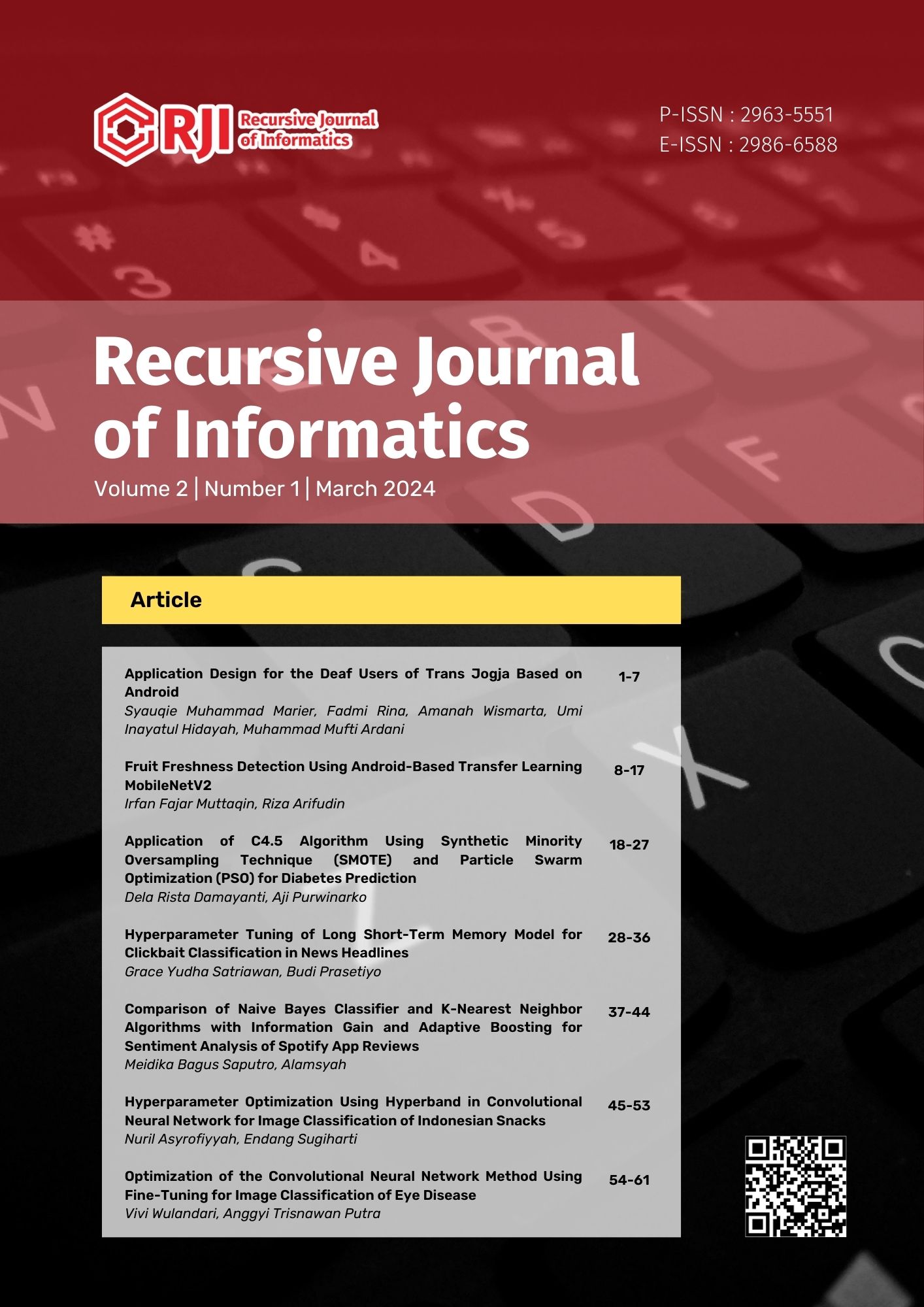Application Design for the Deaf Users of Trans Jogja Based on Android
Abstract
Abstract This study proposes the design and development of an Android application tailored specifically for the deaf users of the Trans Jogja public transportation system. With the aim of enhancing accessibility and usability for this marginalized user group, the application integrates features that cater to their unique communication needs and challenges.
Purpose: Universitas Nahdlatul Ulama Yogyakarta has a Disability Services Unit or ULD called GESI. This unit accommodates the accessibility needs of deaf students. Deaf students usually use Trans Jogja as a means of transportation to campus. An obstacle that students often face is missing the location of their destination bus stop. This happens because students are too busy playing with their cell phones, causing a loss of focus. Therefore, tools are needed as a reminder of the location of the destination bus stop. This research aims to design a tool application for deaf students using Android-based Trans Jogja public transportation.
Methods/Study design/approach: This research methods uses a prototype which includes communication, quick plan and design modeling, construction of prototype, and development delivery feedback.
Result/Findings: The results of this research are in the form of a prototype that has several features, namely searching for starting and destination stops, text to voice, word dictionary, volume settings, and distance settings.
Novelty/Originality/Value: The design of an application to assist deaf people in using Trans Jogja based on Android is used for students with hearing impairments, especially for Trans Jogja public transportation.
References
[2] W. Paramitha and H. P. Lestari, “Solution of the shortest route problem on Trans Jogja bus routes with the Floyd Warshall algorithm,” Proceedings of The 4th International Seminar on Innovation in Mathematics and Mathematics Education (Isimmed) 2020: Rethinking the role of statistics, mathematics and mathematics education in society 5.0: Theory, research, and practice, 2022, Published, doi: 10.1063/5.0111841.
[3] R. S. Pressman, Software Engineering: A Practitioner’s Approach. McGraw-Hill Science, Engineering & Mathematics, 2010.
[4] Łukasz Młodystach, M. Orczyk, and F. Tomaszewski, “Evaluation of public transport in Poland form the perspective of the deaf and hard of hearing people towards the improvement of mobility”, AoT, vol. 66, no. 2, pp. 61–76, Jun. 2023, doi: 10.5604/01.3001.0016.3130.
[5] M. Cerdan Chiscano, “Improving the design of urban transport experience with people with disabilities,” Research in Transportation Business & Management, vol. 41, p. 100596, Dec. 2021, doi: 10.1016/j.rtbm.2020.100596.
[6] P. Ranjbar, P. K. Krishnakumari, J. Andersson, and M. Klingegård, “Vibrotactile guidance for trips with autonomous vehicles for persons with blindness, deafblindness, and deafness,” Transportation Research Interdisciplinary Perspectives, vol. 15, p. 100630, Sep. 2022, doi: 10.1016/j.trip.2022.100630.
[7] P. S. Venkataram, J. A. Flynn, Md. M. R. Bhuiya, J. M. Barajas, and S. Handy, “Availability and usability of transportation for people with disabilities depending on what the user is expected to do,” Transportation Research Interdisciplinary Perspectives, vol. 23, p. 100960, Jan. 2024, doi: 10.1016/j.trip.2023.100960.
[8] K. Lumsden and A. Black, “‘Sorry, I’m dead, it’s too late now’: barriers faced by D/deaf citizens when accessing police services,” Disability & Society, vol. 37, no. 3, pp. 476–495, Oct. 2020, doi: 10.1080/09687599.2020.1829555.
[9] Y. N. Ifriza, T. W. Veronika, T. Suryarini, and A. Supriyadi, “The Modeling Of Laboratory Information Systems In Higher Education Based On Enterprise Architecture Planning (EAP) For Optimizing Monitoring And Equipment Maintenance,” MATRIX : Jurnal Manajemen Teknologi dan Informatika, vol. 13, no. 1, pp. 1–11, Mar. 2023, doi: 10.31940/matrix.v13i1.1-11.
[10] S. M. Marier and P. F. Dewi, “Tahfidz Quran Monitoring System in Islamic Boarding Schools,”
Telematika, vol. 18, no. 1, p. 1, Mar. 2021, doi: 10.31315/telematika.v18i1.3931.
[11] S. M. Marier and A. S. Abadi, “The Design of an Android-Based Integrated Islamic Boarding School Information System as a Solution to the Impact of Covid-19,” vol. 18, no. 3, 2021.
[12] Peraturan Daerah Provinsi Daerah Istimewa Yogyakarta Nomor 4 Tahun 2012 tentang Perlindungan dan Pemenuhan Hak-Hak Penyandang Disabilitas.
[13] R. N. Rahayu, “Pemenuhan Layanan Publik Yang Aksesibel Bagi Penyandang Disabilitas Netra.
[14] A. D. B. Sembiring, “Perencanaan Pengadaan Fasilitas Bagi Moda Penghubung Bis Trans Jogja,” 2018.
[15] Y. Wirna, E. C. Silitonga, M. F. R. Putri, and Z. Zulmiyetri, “Aplikasi Korektor Kalimat Berbasis Android Untuk Anak Tunarungu,” INVOTEK: Jurnal Inovasi Vokasional dan Teknologi, vol. 18, no. 2, pp. 41-48, Aug. 2018, doi: 10.24036/invotek.v18i2.267.









